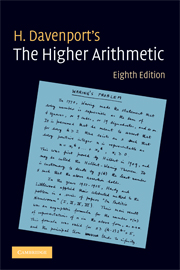VII - Some Diophantine Equations
Published online by Cambridge University Press: 05 June 2012
Summary
Introduction
A Diophantine equation, or indeterminate equation, is one which is to be solved with integral values for the unknowns. We have already met some classical Diophantine equations, for example the equation x2 + y2 = n in Chapters V and VI, and the equation x2 − Ny2 = 1 in Chapter IV.
There is probably no branch of the theory of numbers which presents greater difficulties than the theory (if it can be called a theory) of Diophantine equations. A glance at the extensive literature gives one an impression of a mass of unrelated results on miscellaneous special equations, discovered by highly ingenious devices, which do not seem to fit together into any general theory. After an equation has been solved by some special device, a theory has sometimes been constructed round the solution, which exhibits it in a more reasonable light and enables one to see how far it can be generalized. But the intrinsic difficulties of the subject are so great that the scope of any such theory is usually very limited. Where an extensive theory has developed out of Diophantine equations of a particular type, as with the theory of quadratic forms, it has soon been regarded as having attained an independent status.
In this chapter we shall discuss some Diophantine equations which admit of elementary treatment, and shall mention where possible any general theories which may be associated with them.
- Type
- Chapter
- Information
- The Higher ArithmeticAn Introduction to the Theory of Numbers, pp. 137 - 164Publisher: Cambridge University PressPrint publication year: 2008



